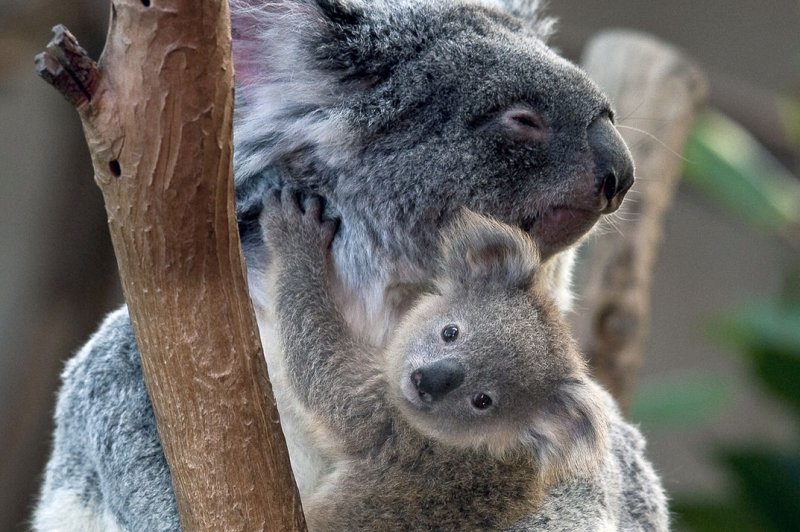
A novel retrovirus is rapidly rewriting the koala genome, and researchers say it is causing high numbers of cancers in the animals. File Photo by Ken Bohn/San Diego Zoo/UPI | License Photo
Feb. 26 (UPI) -- A novel retrovirus is rapidly rewriting the koala genome, and new research -- published Friday in the journal Nature Communications -- suggests the virus, known as the koala retrovirus, or KoRV, is responsible for elevated rates of lymphoma, leukemia and other cancers among northern Australia's koala population.
Like HIV and other retroviruses, KoRV makes copies and inserts its DNA into the host's genome. These mutations can cause health problems.
The genomes of almost all animals, including humans, contain the remnants of past "germ line" infections. Because most of these infections -- identified by degraded viral fragments -- occurred millions of years ago, figuring out how they might have impacted animal health is near impossible.
Koalas, on the other hand, have provided scientists the opportunity to study a retrovirus invasion in real-time.
In Australia and New Zealand, koalas are regularly attacked by dogs and hit by cars. As a result, large numbers of koalas are rescued and rehabilitated -- and tested for diseases.
"The koalas undergo thorough diagnostic procedures under general anaesthetic performed by experienced wildlife veterinarians which allows diagnosis of tumors or cancer," lead study author Gayle McEwen, scientist at the Leibniz Institute for Zoo and Wildlife Research, told UPI in an email.
As a result of this practice, cancer rates among koalas are well documented. Captive and rescued koalas are also regularly tested for KoRV.
RELATED Koala virus could explain junk DNA in the human genome
Because retroviruses have been shown to cause cancer in other animals, researchers hypothesized that KoRV was to blame for elevated cancer rates in koalas.
To confirm the connection, researchers sequenced DNA from wild koalas diagnosed with cancer. Genomic analysis revealed the locations where KoRV had inserted its DNA.
By comparing retrovirus insertion sites between healthy koalas and koalas with cancer, as well as genetic differences between healthy and tumor tissues in individual koalas, researchers identified a strong correlation between KoRV mutations and genes causing cancers common among koalas.
RELATED Remains of leukemia ancestor found in bat genome
When comparing the genomes of different koalas, researchers found KoRV insertion sites varied dramatically. Among the genomes of humans and other animals, the signatures of ancient germ line infection are mostly found in the same places in any two individuals.
"Over time, endogenous retroviruses accumulate mutations and become degraded and so there will be fewer re-integration events and only some specific integrations will remain in the population until eventually all individuals in the population have integrations at the same loci -- ones which don't have a highly deleterious effect," McEwen said.
The diversity of KoRV mutations found in koala genomes confirmed the retrovirus infection is still in its earliest stages. That's bad news for koalas.
"The constant generation of new integrations increases the likelihood that they will land someplace harmful, such as in oncogenes," co-author Alex Greenwood, professor of wildlife diseases at Leibniz-IZW, told UPI.
An oncogene is a gene that has the potential to cause cancer.
Despite the diversity of KoRV insertion sites revealed by the latest analysis, researchers were surprised to find that KoRV mutations were concentrated around certain hotspots.
The proteins that guide the viral DNA insertion process seem to prefer certain sequences in a host's genome.
"Many of the genes that are hotspots are very active -- meaning the DNA tends to be 'open' and accessible," Greenwood said.
Unfortunately, some of the more open, or active, sites on the genome are those that host large concentrations of genes related to cell proliferation.
Because KoRV mutations can affect germ line cells, they can rapidly spread through animal populations."With a normal germ line mutation, there is a 50:50 chance that it will be passed on to offspring from the parent carrying that mutation. However, with KoRV, it can frequently generate new integrations in individuals," McEwen said.
"As multiple KoRV integrations build up, then the chance of any progeny inheriting at least one endogenous KoRV integration from an affected parent becomes more than 50 percent, and this will continue to rise with further integrations," McEwen said.
The findings help explain how rapidly spreading germ line infections by retroviruses can aid the proliferation of serious health problems.
The scientists said they hope to gain further insights into the spread of KoRV mutations and their health affects by analyzing the genomes of groups of koalas living on islands, where they've separated from larger population.
They also plan to study the links between KoRV mutations and other koala disease, including chronic chlamydia and wasting disease.
upi.com/7078588
No comments:
Post a Comment